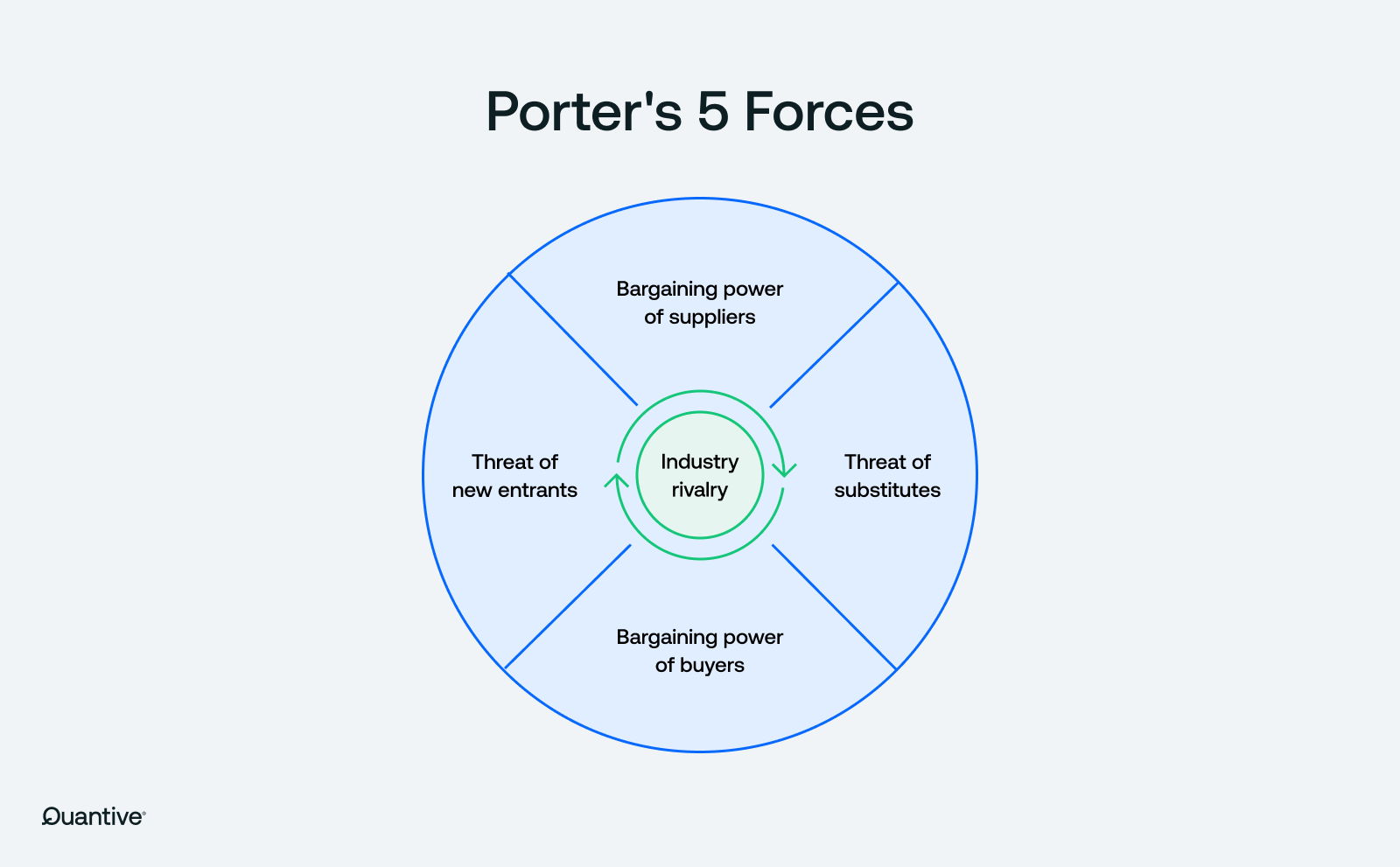Quantive is now part of WorkBoard. Get to know WorkBoard:
Planning the right strategy can be challenging without a structured approach that accounts for all necessary competitive factors. Porter's Five Forces model provides a strategic planning framework to help businesses assess an industry's competitive intensity and attractiveness. This article will give you the ins and outs of Porter's Five Forces, including its:
- Definition
- Elements
- Origins
- Use cases
- Example
- Steps
- Benefits
What is Porter’s 5 Forces model?
Porter's Five Forces is a corporate strategy framework used to analyze an industry or a market’s competitive intensity and attractiveness. It helps businesses understand the level of competition and potential profitability of entering or staying within a specific market.

What are the core elements of Porter’s Five Forces?
- Threat of new entrants: How easy is it for new competitors to enter the market?
- Bargaining power of suppliers: How much power do suppliers have to influence prices and terms?
- Bargaining power of buyers: How much power do customers have to influence prices and terms?
- Threat of substitute products or services: How likely are customers to switch to alternative products or services?
- Competitive rivalry: How intense is the competition among existing firms? Who are your existing competitors?
Who developed the Porter’s Five Forces Model?
Michael E. Porter, a renowned Harvard Business School professor, introduced the Five Forces model in his 1979 book, "Competitive Strategy: Techniques for Analyzing Industries and Competitors”. Years later, he further examined these ideas in an article in the Harvard Business Review.
When to use Porter’s Five Forces?
Business leaders can use Porter’s Five Forces to shape strategy in several scenarios for a comprehensive competitive environment evaluation:
- Entering a new industry or market: When planning to enter a new industry or market, Porter’s Five Forces helps you understand the competitive dynamics, potential barriers to entry, and the industry profitability outlook, enabling informed decision-making.
- Analyzing the competitive landscape of an existing market: You can use Porter’s Five Forces to analyze the intensity of current competition, the power dynamics among suppliers and buyers, and the threat of substitutes, helping you identify potential strategic adjustments.
- Developing a business strategy: When crafting a new business strategy, Porter’s Five Forces provides a structured approach to evaluate external competitive forces, ensuring that a robust and aligned strategy.
- Evaluating potential mergers or acquisitions: Before pursuing mergers or acquisitions, Porter’s Five Forces helps assess the attractiveness and risks associated with the target industry.
- Responding to competitive changes: In times of significant market disruption, Porter's Five Forces help identify the implications of these changes and guide strategic responses to maintain competitive advantage.
Porter’s 5 Forces analysis example: Xiaomi in the urban mobility market
Let’s imagine that Xiaomi, which already manufactures mobile phones and electric scooters, is considering entering the urban mobility market in Europe, starting in London. They could use Porter’s Five Forces to assess the competitive landscape of the urban mobility market in London:
- Threat of new entrants: High due to low barriers to entry for many electric scooter manufacturers
- Bargaining power of suppliers: Moderate, as there are multiple suppliers for key components like batteries and motors
- Bargaining power of buyers: High, as consumers have many choices and low switching costs
- Threat of substitute products: High, with options like bicycles, public transportation, and ride-sharing services
- Competitive rivalry: Intense, with numerous players and rapid technological advancements
How to use Porter’s Five Forces in your organization?
Here’s a step-by-step guide to help you use Porter’s Five Forces framework effectively:
Step 1: Identify key players in your industry
To set the context for your forces analysis, start by identifying the major players in the industry, including industry structure, industry competition, suppliers, buyers, potential new entrants, and substitutes. Document key details about each player, such as market share, influence, and strategic positioning.
Step 2: Analyze the strength of each of the five forces
Evaluate the impact of each of Porter’s Five Forces on your industry. Consider factors like:
- Threat of new entrants: Assess barriers like capital requirements, economies of scale, brand loyalty, and regulatory hurdles.
- Bargaining power of suppliers: Determine the concentration of suppliers, the availability of substitute inputs, and the importance of your industry to suppliers.
- Bargaining power of buyers: Examine the concentration of buyers, the availability of alternative products, and the price sensitivity of customers.
- Threat of substitutes: Identify the presence of alternative products or services that can perform the same function as your industry’s offerings.
- Competitive rivalry: Analyze the number and strength of competitors, industry growth rates, and the level of differentiation among products and services. Use this to create a competitive strategy.
Step 3: Assess the overall attractiveness of the industry
Based on your analysis of the five forces, evaluate the overall attractiveness and profitability of the industry. An industry with significant competitive intensity, powerful suppliers and buyers, low barriers to entry, and numerous substitutes may be less attractive and less profitable.
Step 4: Develop strategic responses to each force
Create strategies to address the findings from your analysis. For example:
- Strengthen barriers to entry: Increase capital requirements, achieve economies of scale, or enhance brand loyalty to deter new entrants
- Manage supplier power: Develop multiple sourcing options, create supplier alliances, or integrate vertically
- Reduce buyer power: Enhance product differentiation, increase switching costs, or target less price-sensitive customer segments
- Mitigate threats from substitutes: Innovate new features, improve product quality, or create customer loyalty programs
- Navigate competitive rivalry: Focus on niche markets, form strategic alliances, or compete on factors other than price, such as quality or service
Step 5: Monitor and adapt to industry changes
Continuously monitor changes in the industry and reassess the five forces regularly. Stay informed about new entrants, supplier and buyer dynamics changes, emerging substitutes, and shifts in competitive rivalry. Adapt your strategies accordingly to maintain a competitive edge.
What are the benefits of using Porter’s Five Forces?
Porter’s model provides several specific advantages for businesses. These benefits include:
- Clear industry breakdown: Helps businesses understand the structure of their industry and the different forces at play.
- Profitability insights: Identifies the key drivers of profitability within the industry, enabling businesses to focus on critical areas where strategic adjustments can significantly improve margins and overall financial performance.
- Better negotiation power: By understanding the power dynamics between suppliers and buyers, businesses can enhance their negotiating position and secure better terms and conditions that can lead to cost savings and improved supply chain stability.
Maximize market opportunities with Quantive StrategyAI
Quantive StrategyAI can streamline the adaptation of your external market environment and business changes by providing data-driven insights and analysis.
It can help you quickly assess an industry's competitive intensity, identify key players, and understand the underlying forces driving competition. This empowers you to make informed strategic decisions and gain a competitive edge.





